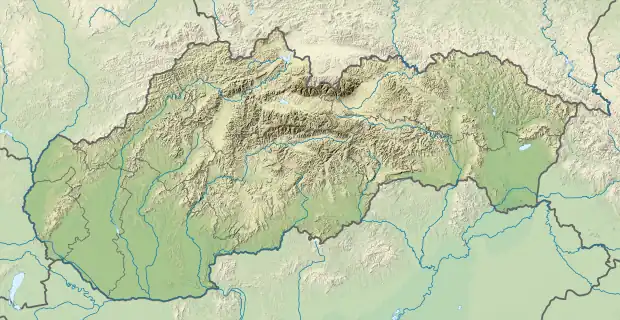Dobrohošť
Doborgaz | |
|---|---|
village | |
 Location of the village | |
| Coordinates: 47°58′56″N 17°21′39″E / 47.98222°N 17.36083°E | |
| Country | |
| Region | Trnava |
| District | Dunajská Streda |
| First written mention | 1238 |
| Government | |
| • Mayor | József Boráros[1][2] |
| Area | |
| • Total | 4.70[3] km2 (1.81[3] sq mi) |
| Elevation | 122[4] m (400[4] ft) |
| Population (2021)[5] | |
| • Total | 502[6] |
| • Estimate (2008) | 403 |
| Ethnicity | |
| • Hungarians | 91.37% |
| • Slovaks | 8.63% |
| Time zone | UTC+1 (EET) |
| • Summer (DST) | UTC+2 (EEST) |
| Postal Code | 930 31[4] |
| Area code | +421 31[4] |
| Website | www |
Dobrohošť (Hungarian: Doborgaz, pronounced [ˈdoborɡɒz]) is a village and municipality in the Dunajská Streda District in the Trnava Region of south-west Slovakia.
History
In historical records the village was first mentioned in 1238, when it was the part of the Kingdom of Hungary. After the Austro-Hungarian army disintegrated in November 1918, Czechoslovak troops occupied the area, later acknowledged internationally by the Treaty of Trianon. Between 1938 and 1945 Dobrohošť once more became part of Miklós Horthy's Hungary through the First Vienna Award. From 1945 until the Velvet Divorce, it was part of Czechoslovakia. Since then it has been part of Slovakia.
Geography
The municipality lies at an altitude of 123 metres and covers an area of 4.855 km². It has a population of about 371 people.
See also
References
- ↑ Election results 2006 Archived August 11, 2011, at the Wayback Machine
- ↑ Local election 2010 results by the Statistical Office of the Slovak Republic Archived August 11, 2011, at the Wayback Machine
- 1 2 "Hustota obyvateľstva - obce [om7014rr_ukaz: Rozloha (Štvorcový meter)]". www.statistics.sk (in Slovak). Statistical Office of the Slovak Republic. 2022-03-31. Retrieved 2022-03-31.
- 1 2 3 4 "Základná charakteristika". www.statistics.sk (in Slovak). Statistical Office of the Slovak Republic. 2015-04-17. Retrieved 2022-03-31.
- 1 2 "Institute of Informatics and Statistics". Archived from Institute of Informatics and Statistics the original on 2011-02-26.
{{cite web}}: Check|url=value (help) - ↑ "Počet obyvateľov podľa pohlavia - obce (ročne)". www.statistics.sk (in Slovak). Statistical Office of the Slovak Republic. 2022-03-31. Retrieved 2022-03-31.
Genealogical resources
The records for genealogical research are available at the state archive "Štátny Archív in Bratislava, Slovakia"
- Roman Catholic church records (births/marriages/deaths): 1673-1906 (parish B)
- Lutheran church records (births/marriages/deaths): 1706-1895 (parish B)
External links